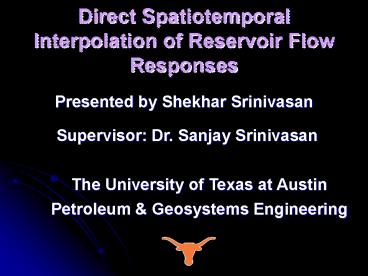SPACE TIME MODELING - PowerPoint PPT Presentation
1 / 19
Title:
SPACE TIME MODELING
Description:
Direct Spatiotemporal. Interpolation of Reservoir Flow Responses. Presented by Shekhar Srinivasan ... The University of Texas at Austin. Petroleum & Geosystems ... – PowerPoint PPT presentation
Number of Views:60
Avg rating:3.0/5.0
Title: SPACE TIME MODELING
1
Direct SpatiotemporalInterpolation of Reservoir
Flow Responses
Presented by Shekhar Srinivasan
Supervisor Dr. Sanjay Srinivasan
The University of Texas at Austin
Petroleum Geosystems Engineering
2
History Matching
- Sensitivity analysis
Porosity
Permeability
Rock fluid compressibilities
Saturations
3
History Matching
- Geologist provides prior permeability field
- Change permeability map simulate production
- Check match of production history
Perm field
Change map
Production response
4
Objective of Problem
Sampled pressure transients
Desired pressure data
P
P
P
t
t
t
P
15000 ft
?
P
P
t
P
t
t
P
t
t
P
P
t
P
t
t
15000 ft
5
Time series modeling
- Fit time series through pressure response
- at sampled wells
Known basis functions
a0
a1
a2
f2 (t)
an
fn (t)
f1 (t)
P
sin (w t )
P
c y t
e -t
t
6
Wavelets A Handy Tool
Scale 2
Scale 1
Original image
7
Inverse transform
Scale 2
Scale 1
Reconstructed image
8
Scaling Translation
Scaling parameter m
Translation parameter n
9
Identify structure
Sm(32)
- Isolate noise from signal
- Average - smooth structure
- Details noise (no structure)
- Averages split further
(16)Am-1
Dm-1(16)
Dm-2(8)
(8)Am-2
(4)Am-3
Dm-3(4)
Noise
Trend
Transient map
10
Well Model
Plot map at various scales
15000 ft
15000 ft
15000 ft
15000 ft
- Underlying permeability field unknown
- Pressure history measured at wells is decomposed
using wavelets - Maps of coefficients are plotted at different
scales
11
Infer spatial variability
3rd time window
1st time window
4th time window
2nd time window
- Observe
- 1st time window shows effect of fluid
compressibility - 2nd, 3rd, 4th windows show effect of underlying
geology flow rate
12
Information Networking
13
Model spatial correlation
- Small variability for closely spaced locations
due to identical responses - Variability increases with lag spacing
14
Sequential simulation
15
Simulated maps at various scales
3rd time window
1st time window
4th time window
2nd time window
- OBSERVE
- Spatial variability at multiple scales distinctly
visible - Reinforce multiscale reservoir operation
16
Reconstruction
- Collect coefficients from simulated maps
- Inverse wavelet transform
17
Summary
?
?
Pressure data
Wavelet decomp
Coefficients
At all wells
?
Semivariogram
Interpolation
Maps
Reconstruction
18
Advantages
- Quicker technique for reservoir model validation
- Optimal location of wells based on predicted
pressure response - General technique used for hydrogeological
environmental remediation problems
19
Questions?































